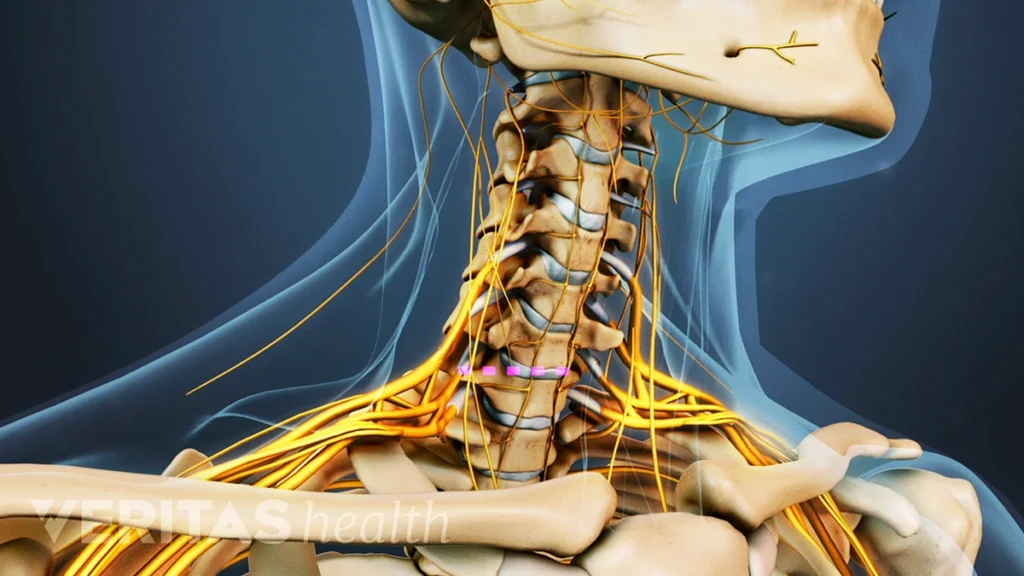Cervical Spinal Stenosis

Cervical Spinal Stenosis
Contact Us
Related Videos :
Frequently Asked Questions (FAQ) :
What are the chances of recovery from a brain tumor?
- Recovery depends on the type, size, and location of the tumor, as well as the patient’s overall health. Early diagnosis and expert treatment can improve the chances of recovery.
Can brain tumors be prevented?
- While most brain tumors cannot be prevented, reducing exposure to known risk factors, like radiation and environmental toxins, can help lower the risk.
Is brain tumor surgery risky?
All surgeries carry some risk. However, advancements in neurosurgical techniques, such as those used by Dr. Sandeep Vaishya, have made brain tumor surgeries safer with better outcomes.

What is Cervical Spinal Stenosis?
Cervical spinal stenosis refers to the narrowing of the spinal canal in the cervical (neck) region. This narrowing can exert pressure on the spinal cord or nerves, leading to pain, discomfort, and other neurological symptoms.
Key Points:
- Affects the neck area (Cervical spine)
- Can cause pain, weakness, and loss of coordination
- Common in people over 50, but can affect younger individuals as well
Causes of Cervical Spinal Stenosis
Cervical spinal stenosis typically develops gradually over time. It can be caused by several factors, including:
- Age-related degeneration: The most common cause of spinal stenosis is aging. As we age, the discs in our spine lose water content, leading to a loss of flexibility and height, which can cause the spinal canal to narrow.
- Herniated discs: A disc may bulge out of place and compress the spinal cord or nerves.
- Bone spurs: Arthritis or other conditions may cause extra bone to form, narrowing the spinal canal.
- Injury: Trauma to the neck can lead to swelling, displacement of vertebrae, or other changes that cause stenosis.
- Genetic conditions: Some people are born with a narrower spinal canal.
Types of Cervical Spinal Stenosis
Cervical spinal stenosis can be classified into two main types based on its location and impact:
- Central Stenosis: Narrowing of the central spinal canal, which can compress the spinal cord.
- Foraminal Stenosis: Narrowing of the small openings (foramina) through which nerve roots exit the spinal canal, leading to nerve compression.
Symptoms of Cervical Spinal Stenosis
Symptoms of cervical spinal stenosis may vary depending on the severity of the condition, but the most common include:
- Neck pain: Persistent or intermittent pain in the neck.
- Numbness and tingling: Typically in the arms, hands, or fingers.
- Weakness: Difficulty with coordination or holding objects.
- Balance problems: Issues with walking or standing steadily.
- Radiating pain: Pain may extend from the neck to the shoulders, arms, and legs.
- Loss of bowel or bladder control: In severe cases, compression of the spinal cord can lead to issues with bladder and bowel function.
Diagnosis of Cervical Spinal Stenosis
Accurate diagnosis is key to successful treatment. Dr. Sandeep Vaishya uses a combination of clinical evaluations and advanced diagnostic imaging to determine the extent of stenosis. The most common diagnostic methods include:
- Physical examination: Assessment of symptoms, reflexes, and muscle strength.
- X-rays: To identify changes in the bones, such as bone spurs or disc degeneration.
- MRI (Magnetic Resonance Imaging): Provides detailed images of the soft tissues, including discs and the spinal cord.
- CT Scan: Helps visualize the bony structures of the spine in more detail.
- Myelogram: An imaging test that involves injecting a contrast dye to highlight the spinal cord and nerves during X-rays or CT scans.
Treatment for Cervical Spinal Stenosis
Treatment options for cervical spinal stenosis depend on the severity of symptoms and the underlying cause. Dr. Sandeep Vaishya offers a variety of treatments, including both non-surgical and surgical options.
Non-Surgical Treatments:
- Physical Therapy: Helps improve strength, flexibility, and posture to relieve pressure on the spine.
- Medications: Pain relievers, anti-inflammatory drugs, and muscle relaxants may be prescribed.
- Steroid Injections: Corticosteroid injections can reduce inflammation and pain in the affected area.
- Bracing: A neck brace may be used temporarily to support the neck and reduce pressure.
Cost of Cervical Spinal Stenosis Treatment in India
India is a popular destination for high-quality yet affordable medical treatments. Dr. Sandeep Vaishya is one of the most trusted neurosurgeons in the country, providing world-class care at a fraction of the cost compared to Western countries.
- Cost Range: The cost for cervical spinal stenosis treatment, including surgery, ranges from $4,000 to $10,000 USD, depending on the complexity of the surgery and the patient’s condition.
- Inclusions: This cost typically covers hospitalization, surgeon’s fees, diagnostic tests, medications, and post-surgery care.
- Additional Costs: Patients should budget for travel, accommodation, and any additional rehabilitation services post-surgery.